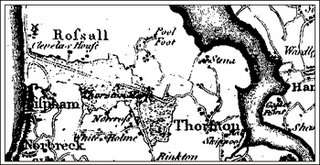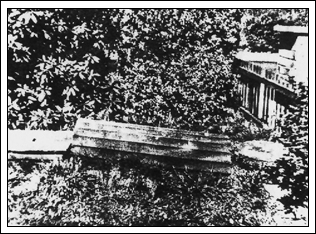Let’s start with the following extract taken from an article by the late Ben Bowman for the Blackpool Gazette and Herald: “At Cleveleys there was no highway to Thornton until Ramper Road (now Victoria Road) was constructed of gravel over the marsh to Thornton, under an order called the Marsh Act Award of 1805.”
Which, on the surface, is all very well and good…but, unfortunately, wrong. If the truth be known a cursory glance at Yates’ map of 1786 (nineteen years prior to the aforementioned Marsh Act) shows us that Victoria Road, nee Ramper Road, was already well and truly established towards the end of the eighteenth century.

So exactly how old is Victoria Road? Well, structurally, the entire highway is built on the top of an agger of sand. In the 1990s as work was being conducted to narrow the section by Cleveleys traffic lights into a single lane, we happened to be passing (without a camera, unfortunately) and took a glance into the trench. Roughly six to eight feet down were a series of upright wooden joists, extremely old in appearance and partially rotted. Whether these had been used in the road’s original construction, or whether the council were just recycling ancient timbers, we couldn’t honestly say.
Whatever the case, Victoria Road is extremely long and extremely straight…especially considering the crooked nature of most pre-nineteenth century byways in the Wyre. So, the obvious question arises, was it Roman?
Here’s something you can try at home. Take an accurate map of the district…an Ordnance Survey for preference…place a ruler against Victoria Road and, with the aid of a pencil, continue in a perfectly straight line to the east. Surprisingly the road doesn’t head for Stanah as you might expect. It actually reaches Bulker Ford (the cuttings of which are shown below) a suspected Roman crossing that originally ran over the River Wyre to Banks Farm in Hambleton. In fact, even today if you look across the river at low tide you can see the stones on the opposite bank stretching out into the water.

And here’s another thing…some time ago we were rummaging through the drawers at Fleetwood library when we pulled out a sheet of photographs that caught our attention. Two of them showed carved stone blocks denoting previous occupation by the Ministry of Defence; World War Two relics that were probably part of somebody’s local history thesis. The other photographs, however, were of the fractured column shown below.

Which, on the surface, is all very well and good…but, unfortunately, wrong. If the truth be known a cursory glance at Yates’ map of 1786 (nineteen years prior to the aforementioned Marsh Act) shows us that Victoria Road, nee Ramper Road, was already well and truly established towards the end of the eighteenth century.

So exactly how old is Victoria Road? Well, structurally, the entire highway is built on the top of an agger of sand. In the 1990s as work was being conducted to narrow the section by Cleveleys traffic lights into a single lane, we happened to be passing (without a camera, unfortunately) and took a glance into the trench. Roughly six to eight feet down were a series of upright wooden joists, extremely old in appearance and partially rotted. Whether these had been used in the road’s original construction, or whether the council were just recycling ancient timbers, we couldn’t honestly say.
Whatever the case, Victoria Road is extremely long and extremely straight…especially considering the crooked nature of most pre-nineteenth century byways in the Wyre. So, the obvious question arises, was it Roman?
Here’s something you can try at home. Take an accurate map of the district…an Ordnance Survey for preference…place a ruler against Victoria Road and, with the aid of a pencil, continue in a perfectly straight line to the east. Surprisingly the road doesn’t head for Stanah as you might expect. It actually reaches Bulker Ford (the cuttings of which are shown below) a suspected Roman crossing that originally ran over the River Wyre to Banks Farm in Hambleton. In fact, even today if you look across the river at low tide you can see the stones on the opposite bank stretching out into the water.

And here’s another thing…some time ago we were rummaging through the drawers at Fleetwood library when we pulled out a sheet of photographs that caught our attention. Two of them showed carved stone blocks denoting previous occupation by the Ministry of Defence; World War Two relics that were probably part of somebody’s local history thesis. The other photographs, however, were of the fractured column shown below.

An accompanying address indicated that the pillar was lying in a garden to the rear of Victoria Road East.
Interestingly, perhaps, if you chart the various accounts of people who claim to have discovered the Fleetwood peninsula end of the Danes’ Pad in their gardens, plot them on a map, tilt your head on one side and squint, then the address on the photographs corresponds exactly with the spot where the Danes’ Pad met with Victoria Road.
Evidence of Roman occupation in Thornton? Well…probably not, and as we’re not very fond of cold calling (the idea of two suspicious looking characters turning up on householders’ doorsteps unannounced generally sends them into paroxysms of fear) we haven’t unravelled this mystery yet…although, of course, if anybody can identify the photographs and explain what they are we’d be extremely grateful.
If Victoria Road was built in Roman times then, assuming that Bulker was its destination to the east, where was its origin in the west? Well…presumably its starting point was Ritherham, or Ritherholme as it’s sometimes known; the forerunner to Cleveleys that historians often forget existed. Ritherham, of course, is an old english name meaning the ‘village by the stream’, though where the stream was is anybody’s guess. Whatever the case, the name isn’t old enough for the Roman period, and therein lies a bit of a problem.
Rossall Grange, the original manor belonging to Duelacres Abbey, apparently fell into the sea long before the ‘modern’ building we know as Rossall School was constructed. Claims from ‘antiquarian divers’ tend to place this ancient, monastic building at roughly two miles off the coast. (Actually, we find this hard to believe; a few hundred yards perhaps…but two miles?) Prehistoric forests, Bronze Age settlers, the missing village of Singleton Thorpe destroyed by some sort of tsunami in the sixteenth century…all of these places have, at one time or another, been located and ‘verified’ around the low-water mark indicating that a sizeable chunk of land between Rossall and Bispham has since vanished. So, was there something of importance to the Romans just off Cleveleys promenade?
There certainly was at Rossall Point where the famous coin hoards were dug out of the rabbit warren, although exactly what the Romans had built there it’s now impossible to say. The chances are a coastal route, now destroyed and scattered by the pounding of the waves, once led all the way from the Starr Hills to the Mount in Fleetwood, Victoria Road acting as a byway to reach it. Of course, at the moment we couldn’t say for certain but, as always, it doesn’t stop us speculating on the possibilities.
Interestingly, perhaps, if you chart the various accounts of people who claim to have discovered the Fleetwood peninsula end of the Danes’ Pad in their gardens, plot them on a map, tilt your head on one side and squint, then the address on the photographs corresponds exactly with the spot where the Danes’ Pad met with Victoria Road.
Evidence of Roman occupation in Thornton? Well…probably not, and as we’re not very fond of cold calling (the idea of two suspicious looking characters turning up on householders’ doorsteps unannounced generally sends them into paroxysms of fear) we haven’t unravelled this mystery yet…although, of course, if anybody can identify the photographs and explain what they are we’d be extremely grateful.
If Victoria Road was built in Roman times then, assuming that Bulker was its destination to the east, where was its origin in the west? Well…presumably its starting point was Ritherham, or Ritherholme as it’s sometimes known; the forerunner to Cleveleys that historians often forget existed. Ritherham, of course, is an old english name meaning the ‘village by the stream’, though where the stream was is anybody’s guess. Whatever the case, the name isn’t old enough for the Roman period, and therein lies a bit of a problem.
Rossall Grange, the original manor belonging to Duelacres Abbey, apparently fell into the sea long before the ‘modern’ building we know as Rossall School was constructed. Claims from ‘antiquarian divers’ tend to place this ancient, monastic building at roughly two miles off the coast. (Actually, we find this hard to believe; a few hundred yards perhaps…but two miles?) Prehistoric forests, Bronze Age settlers, the missing village of Singleton Thorpe destroyed by some sort of tsunami in the sixteenth century…all of these places have, at one time or another, been located and ‘verified’ around the low-water mark indicating that a sizeable chunk of land between Rossall and Bispham has since vanished. So, was there something of importance to the Romans just off Cleveleys promenade?
There certainly was at Rossall Point where the famous coin hoards were dug out of the rabbit warren, although exactly what the Romans had built there it’s now impossible to say. The chances are a coastal route, now destroyed and scattered by the pounding of the waves, once led all the way from the Starr Hills to the Mount in Fleetwood, Victoria Road acting as a byway to reach it. Of course, at the moment we couldn’t say for certain but, as always, it doesn’t stop us speculating on the possibilities.



















2 comments:
Has there been any finding/updates since 2006?
Post a Comment